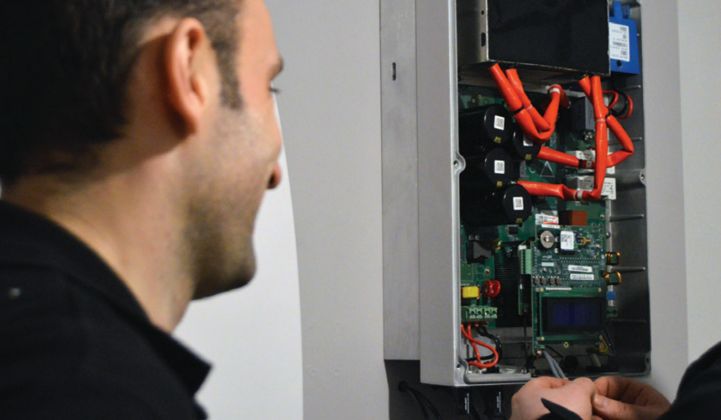Solar module-level power electronics maker SolarEdge has been quietly putting its own solar-battery inverter control system, dubbed StorEdge, into the field over the past couple years. But energy storage still makes up only a tiny fraction of its growing share of business in the highly competitive global solar inverter industry.
On Tuesday, SolarEdge announced a big new partner in the solar-storage space that could change that equation.
PetersenDean Roofing & Solar, the largest privately held U.S. solar and roofing company, announced that it’s pairing the StorEdge systems with 9.8-kilowatt-hour LG Chem batteries to provide homeowners “an affordable path to solar ownership and energy storage.”
It’s not the first solar-storage partnership for PetersenDean -- the company has worked with Sunverge and Sonnen in the past. CEO Jim Peterson has called solar-storage the “new backbone for the future of our nation’s electric power and renewable energy industries,” indicating the company’s interest in finding a cost-effective way to bring the combination’s full array of capabilities to market.
While Tuesday’s announcement didn’t reveal pricing, in an August 2017 review of the StorEdge-LG system, Greentech Media priced a typical system at $9,950 -- $5,550 for the battery, $2,600 for the inverter, and the rest for the meters, transformers and communications systems. That’s a hefty premium over a simple rooftop solar system, and quite a bit more than the cost of a backup generator that could provide homeowners a similar level of security against grid blackouts.
But Petersen noted in Tuesday’s announcement that customers will “save substantially in the long term” by storing excess solar energy to draw upon later, whether to avoid “unnecessary fees and taxes,” or providing “flexibility in an ever-changing utility landscape.”
To make that possible, the StorEdge-LG system is designed to work in both off-grid and grid-tied modes, Peterson noted. With the proper predictive analytics and controls, these systems could store excess solar energy during midday, and use it to reduce their own load later in the day, when grid demand is peaking and time-of-use prices are rising, for example.
This kind of payback potential implies an economic and regulatory structure that doesn’t exist in much of the country, of course. To date, residential solar-storage systems have primarily been sold as emergency backup power, rather than as grid assets. (This is changing, however, as Emma Foehringer Merchant outlined in her recent Squared column.)
Residential still makes up a relatively small share of the overall market for behind-the-meter battery systems, which is dominated by large commercial, industrial, government and institutional customers. That’s because most markets don’t offer customers the incentives needed to cover the additional cost.
But last year saw a bit of a boom in residential energy storage, driven by policies in California and Hawaii. According to the most recent GTM Research-Energy Storage Association U.S. Energy Storage Monitor, nine new grid-connected home energy storage systems were deployed per day through the third quarter of 2017, totaling 4.2 megawatts, amounting to growth of 202 percent year-over-year.
In Hawaii, home of the highest electricity rates in the nation, solar-storage is making economic sense under the state’s Customer Self-Supply Program. In California, the Self-Generation Incentive Program, with its carve-out for residential storage systems, has helped drive growth.
Other states and utilities are trying out models that spread the costs of batteries and power electronics over time. In Vermont, utility Green Mountain Power is offering Tesla Powerwall batteries (and SolarEdge inverters) to customers to be paid for in monthly installments through their utility bills, in exchange for being able to use them to manage its own system needs.
Last week, SolarEdge reported fourth-quarter revenue of $189.3 million, up 70 percent year-over-year, and full-year revenues of $607.0 million, up 24 percent from 2016. This strong performance has given the company the chance to invest in research and development -- fourth-quarter R&D expenses were $16.4 million, up 50 percent from the same quarter last year.
CEO Guy Sella highlighted SolarEdge's R&D goals in last week's earnings conference call. "We are working extensively on growing the range of 3-phase inverters in order to reach very high sizes. None of these will happen over one year. Those are developments that spread over 18- to 30- month programs, but we have projects running almost any size of inverter," he said. "We keep developing ASICs [application-specific integrated circuits] to control more and more of [that]...component in our product. We are investing heavily in next-generation, and the generation after next, of optimizers.”
But energy storage was mentioned only once, as a tag-end to a long list of R&D initiatives. Sometime soon -- although not this year -- “We’ll come up with a next generation of storage product, which will be a step ahead of what you can find today in the market,” he said.




